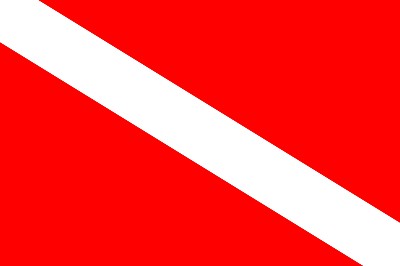10% OFF WITH CODE:
BLACKFRIDAY10
Diving Flags: Colours and Meanings
May 2, 2022
Diving flags are markers used to indicate to other vessels when diving activities are in progress. Using diving flags correctly is vital for the safety of the divers, as other boaters can easily overlook individuals in the water, particularly in choppy or low-visibility conditions.
Here are the two most commonly used diving flags, what they mean and how to recognize them!
Types of diving flags
If you plan to use your vessel for diving excursions, the following flags are vital boating safety equipment to have on board!
The Alpha flag
The Alpha flag, officially known as International Code flag “A”, is a blue and white pennant flag that is flown on a diving vessel. This internationally-recognized flag indicates to other boaters that the vessel is engaged in diving activities and therefore has reduced maneuverability, meaning that other boats must cede the right of way.
According to the International Regulations for Preventing Collisions at Sea, the Alpha flag should be a rigid replica at least 1 m (39 inches) in height, displayed prominently near the highest point of the vessel for optimal visibility.
The diver down flag
The diver down flag is the main diving flag used in North America. It is a red flag with a white diagonal stripe that extends from the top of the hoist to the bottom of the fly. This diving flag is usually flown from a buoy in the water to indicate an area where diving is underway. It can also be attached to a diver so that it follows them through the water.
A diver down flag flown from a buoy should be at least 50 cm (20 inches) in length. It needs to be set high enough above the water that approaching vessels can see it even in choppy conditions, and the buoy must be stable enough to ensure that the flag doesn’t topple over.
Maintaining a safe distance
Diving flags are intended to ensure that other vessels maintain a safe distance from divers and their boats in order to prevent collisions and other accidents. Transport Canada recommends that vessels stay at least 100 m (328 ft) away from a diving flag wherever possible. Similarly, divers should do their best to stay within 100 m (328 ft) of their flag.
In the event that a vessel cannot maintain such a distance (e.g. in a river, inlet or other confined navigation channel), it should slow down, move cautiously and stay as far away from the diving area as possible.
Learn more about safe boating practices with Drive a Boat Canada!
By law, recreational boaters are required to pass an exam and obtain their pleasure craft operator card in order to boat on Canadian waters. Drive a Boat Canada offers a boating safety course that teaches new boaters everything they need to know before taking the boating exam online. Register for the course today and check out our blog for more useful boating safety tips!


